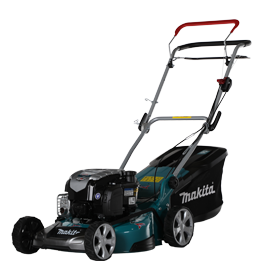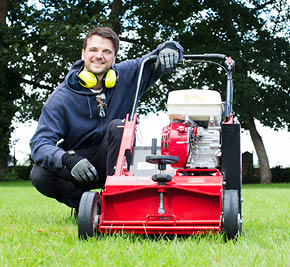
Lawn Mower Buying Guide
If you have grass or a lawn, a lawn mower is going to be an essential piece of gardening kit to have at your disposal.
Keeping grass mown and cared for can actually boost the growth, allowing in a more luscious, thick lawn as opposed to letting it get long and straggly.
Which lawn mower you need depends on how much grass there is to cut, how frequently you can cut it, and the condition of the lawn. In summer months, mowing the lawn every week or fortnight is recommended, but if you don’t have storage space or need a more specialist lawn mower, hiring one from Speedy could be a good option.
We will talk you through everything you need to know below.
Types of Lawn Mower
The power source is key. This can depend on how large your lawn is, whether you’re in a residential area with noise and fume limitations, and how much time you’d like to spend cutting grass.
- Petrol Lawn Mower
Petrol lawn mowers are one of the most powerful options, making light work of overgrown areas and thick grass which needs attention. They’re cordless, which is great for larger gardens where it would be difficult to link to a power source.
Specialist lawn mowers, such as mulching lawn mowers, are usually petrol due to the additional power required.
But this power and fuel type comes at a price. They’re noisier and less eco-friendly than alternatives, and they of course require a supply of petrol.
- Cordless Electric Lawn Mower
Cordless lawn mowers are electric, but work on a battery so don’t require a connection to the mains. This makes them better for larger gardens, and safer too as there’s no risk of the cord getting in the way.
They produce no fumes and are much quieter than petrol alternatives, making them a better option for residential areas or family gardens. Spare batteries can be purchased which will give you more time if you’re mowing a larger lawn.
The downside is the potential downtime from charging batteries, but this shouldn’t be an issue for standard UK gardens.
- Electric Corded Lawn Mower
Corded lawnmowers are usually the cheapest options on the market. They’re lightweight, provide constant runtime with no need to refuel or recharge, and are simple to set up.
Electric mowers are ideal for small lawns, for instance, front gardens or smaller grassed areas. There’s a huge variety available, so you can find one to suit your needs.
They are, however, limited by cable lengths. Larger gardens may struggle for access to a mains plug, and you should try to avoid extension leads. You also have to be careful of the power cord, which can cause a hazard if it gets in the way.
- Ride-on Lawn Mowers
A ride-on lawnmower is for very large lawns, so is unnecessary for most people. They often have a petrol engine and are large and bulky for storage.
If you do have a large lawn or field, they are great for timesaving though.
- Robot Lawn Mowers
Using a GPS signal or boundary wire, a robotic lawnmower does all of the work for you. Set it off using an app, and they move independently to trim your lawn.
They’re quiet and inconspicuous, and work on battery power so are economical. This technology is reflected in their price tag, however. And they will struggle on sloped or bumpy lawns.
Lawn Mower Features
Once you’ve established the power source required, you then need to look at the other features.
Blade Type
When choosing a lawn mower, the blade thickness will tell you how much grass can be cut in each passing. For a larger lawn—or a quicker job—a thick blade will be best.
Collection Type
A lawn mower with a grass box will collect all of the cuttings, allowing you to dispose of them or add them to a compost pile. Without this, the cuttings will be left on top of the grass, which can actually be beneficial if you need to protect the grass in a heatwave or drought. Grass boxes can often be removed depending on your needs.
A mulching lawn mower will instead collect the clippings, and compact them down into plugs, which are then pushed back into the ground. This helps to put these nutrients back into the grass and causes no waste.
Lawns don’t need mulching regularly, so it is a great idea to hire a mulching lawn mower every few weeks in late Spring through to mid-Summer rather than buying one. Mow your lawn as usual in between uses.
Rear Roller
Want that striped look? A rear roller is required to compact the lawn in each direction. They are often push-type mowers rather than self-propelled.
Self-Propelling
A self-propelled lawnmower simply needs to be guided in the correct direction. It will push itself forward, meaning little effort from you. Great for large lawns, inclines, and bumpy areas.
Adjustable Cutting Heights
How long you want your lawn is both an aesthetic and grass health factor. Keeping it a slight bit longer in summer can help prevent the likelihood of scorching and can also help wildlife find shelter from the sun. Similarly, keeping it longer in winter helps keep the roots healthy and helps bugs and birds find food.
Keeping it shorter can be better if you use the lawn regularly (for pets, children, or seating) and can help keep weeds at bay. But you should always be careful not to scalp lawns (cut them too short).
Therefore, adjustable cutting heights can help.
FAQ’s
Which lawn mowers are the best?
The best lawnmower for you depends on your situation. A battery-powered lawnmower will be best for freedom and large gardens, but a petrol lawnmower can give you more power and can especially help you out on those first cuts of the season.
It could be a good idea to purchase a regular electric lawnmower for use weekly in summer, then hire a specialist petrol lawnmower for monthly mulching or unkempt lawns.
What’s the best lawn mower for a large garden?
If you have a large garden which will take a while to cut, you could be best with a petrol lawnmower. These often give long run times, high power and good cutting quality.
If you don’t want to use petrol, you could also try a cordless model, and then hire a professional petrol lawnmower for the first cut of the season. A petrol mower will be able to cut long, unkempt grass with ease.
What is the best cordless lawn mower?
If you’re opting for a battery-powered cordless lawnmower, focus on the battery runtime. If you have a medium to large garden, you will want a long run time on one charge, and a minimal charging time (unless you’re happy to buy another spare battery).
Can I cut wet grass with a petrol lawn mower?
No. We advise never to cut wet grass with any lawnmower. While they aren’t electrically powered as such, wet grass is still harmful to petrol mowers.
Excessive moisture can contaminate petrol in the fuel tank, and can also corrode parts of the lawnmower. Like all lawnmowers, moisture can also cause damage and rust build up on the blade and other parts of the lawnmower, meaning it could eventually stop working and seize up.
Shorter term, wet grass is hard to cut. It can clump around the blade, causing blockages and damage. It will also damage your lawn, as the grass isn’t necessarily being cut, but rather being hacked and pulled as the friction from the blade is poor.
- 2024
- 2023
- December 2023 (13)
- November 2023 (9)
- October 2023 (7)
- September 2023 (10)
- August 2023 (20)
- July 2023 (21)
- June 2023 (17)
- May 2023 (17)
- April 2023 (16)
- March 2023 (14)
- February 2023 (15)
- January 2023 (7)
- 2022
- December 2022 (6)
- November 2022 (12)
- October 2022 (24)
- September 2022 (14)
- August 2022 (12)
- July 2022 (15)
- June 2022 (18)
- May 2022 (14)
- April 2022 (9)
- March 2022 (5)
- February 2022 (5)
- January 2022 (2)
- 2021
- December 2021 (7)
- November 2021 (10)
- October 2021 (1)
- September 2021 (1)
- August 2021 (3)
- July 2021 (3)
- June 2021 (4)
- May 2021 (1)
- April 2021 (1)
- March 2021 (2)
- February 2021 (1)
- January 2021 (1)
- 2020
- 2019
- 2017
- 2016
- 2014
- 2013
- 2012
- 2011



